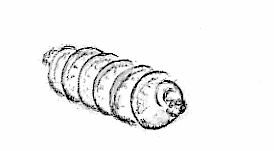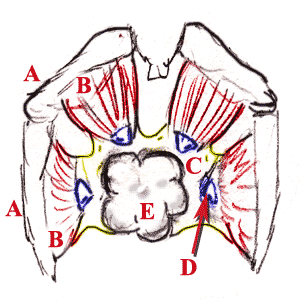 |
Introduction Site Map Email: jja@nac.net |

"I don't know. It is Odin's disk and it has only one side."
— J. L. Borges, The Disk.


Thursday, August 12th, 2004
Computer upgrade is still not accomplished; I'm juggling some hard drives and hope to finish things this weekend. Apologies for the late entry today.
 Continuing from last week, I have designed a critter that
embodies one concept of a land animal that uses the principle of the
screw to get around. The animation at left starts with the bony helix
on which the animal gets about. The rest of the skeleton fades in over
this, and finally the skin and musculature.
Continuing from last week, I have designed a critter that
embodies one concept of a land animal that uses the principle of the
screw to get around. The animation at left starts with the bony helix
on which the animal gets about. The rest of the skeleton fades in over
this, and finally the skin and musculature. The image at right shows a side view, with the helix
colored green.
The image at right shows a side view, with the helix
colored green.The helix is a complex element. For maximum effectiveness, it should be in direct contact with the ground, without any skin intervening, and in this respect should protrude from the flesh under the animal like a tooth. But the helix needs to rotate, and so can't be held in any ordinary socket. I see the helix itself being covered with a thin layer of tough tissue, like periosteum (a membrane that grows over the bones in mammals - when you eat spare ribs and get a translucent membrane caught in your teeth, that's the periosteum). The tissue covers the helix between the ridges, guarding against infection, preventing evaporation of body fluids and retaining the blood supply; the ridges form horny coatings that constantly grow and flake off as the animal grinds them against the rough ground. The animal thus leaves occasional curls of horn behind it as it moves. Jane and Joe Cavedweller should have little trouble tracking this one down... at its best speed, the animal probably does a fractional kilometer per hour.
 At right we are
seeing the animal's 'pelvis', from the rear. The pelvic bones A support the muscles of rotation, B (red). These muscles also assist
in pushing oxygenated blood through the helix bone E, as described further below.
At right we are
seeing the animal's 'pelvis', from the rear. The pelvic bones A support the muscles of rotation, B (red). These muscles also assist
in pushing oxygenated blood through the helix bone E, as described further below. C is a cartileginous circle of tissue (yellow) which forms a tight collar around the knob of the helix bone. It also channels blood flow into the helix bone. The bone has blood vessels that intermittently line up with the channels in the collar in such a way that the muscles, when contracting, also push the blood through the collar and into the helix.
Small deltoid bones D (blue) are embedded in the collar and work against the bumps on the helix knob to cause rotation. I see the muscles expanding like a camera shutter in a clockwise direction, pressing all points against the knob for maximum force.
Referring again to the drawings at the top of the page, we see a pair of paddle-like arms which help the critter to steer itself towards particularly sedentary insects, which it ingests through its trunk.
Difficulties with this design include the helix bone, which is so mechanically complex as to make failure almost certain. In addition, the animal necessarily has a permanently open hole in its skin around each knob of the helix, providing an easy entry point for dirt and bacteria. The primary trouble, of course, is that we're looking for a machine that lets an animal get about readily on land, and this creature would certainly lose, as would the wedge animal, to a turtle wielding simple legs.
At this point, the following simple machines remain to examine: the wheel, pulley, inclined plane and lever. If you can think of an example in nature in which a land animal gets about readily on the screw principle, please drop me a line using the link at the top of the page. (I'm still looking for a good way to add comments to these pages; I don't care for Haloscan since the comments reside on their server. If you know of a good comment system, please let me know.)
Until!



pageatatime.com is hosted by net access corporation - www.nac.net